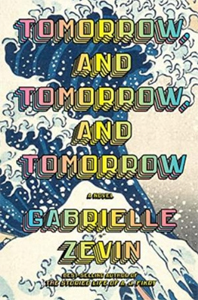With “Tomorrow, and Tomorrow, and Tomorrow” (2022), Gabrielle Zevin does for video games what Michael Chabon did for comic books in “The Amazing Adventures of Kavalier & Clay” (2000). Video games are the major hole in my knowledge of entertainment media, although I enjoyed the basic 1980s Atari and 1990s Nintendo games. So the fact that I was absorbed in all of Zevin’s writings about best friends Sam and Sadie’s game-designing careers shows how great “TTT” is.
While Zevin’s fifth adult novel is certainly a love letter to video games, Sadie says at one point that people play games for the characters, not for the technology. (Zevin’s stand-in is mostly Sadie, in that she is female, although elements of herself filter into Sam, such as being mixed-race.)
If people read books for that reason, too, that explains why “TTT” isn’t merely a vibrant textbook about video-game creation, but also something sweeping and poignant. Most remarkably, we can accurately call Sadie and Sam besties even though most of the book finds them seriously annoyed at each other. Each goes through a stretch of many years of aggressively avoiding the other one.

“Tomorrow, and Tomorrow, and Tomorrow” (2022)
Author: Gabrielle Zevin
Genre: Character drama about up-and-coming video game designers
Setting: 1980s-2000s, Los Angeles and Boston
Note to readers: The Book Club Book Report series features books I’m reading for my book club, Brilliant Bookworms.
Oft-fractured friendship
This isn’t one of those friendships where they always do and say the right thing. It’s one where they are there for each other when it matters, and where they have to work around the other person’s bout of immaturity.
Zevin was born in 1977 and Sadie is her age, with Sam (loosely based on Zevin’s partner) a couple years older. We follow their lives as gaming friends in the 1980s, so late Gen-Xers will love Sadie’s obsession with “Oregon Trail.” The game comes back into play in part nine of the 10-part, 397-page novel when Zevin cleverly uses the POV of gaming characters to lightly disguise the real people.
The author is true to the technology of the Nineties as Sadie and Sam make their first games. “TTT” is filled with details about their first mass-produced hit, “Ichigo,” though always in layman’s terms, or with tech terms smoothly explained. Zevin chronicles marketing, media relations and the pressure to make a sequel. And she includes real-world games as points of comparison, like how “K&C” insert the Escapist into a world that also has Superman and Batman.
You don’t have to absorb the industry details if you don’t want to. You just have to absorb the fact that the details are there; in other words, you absorb the fact that Sam and Sadie are immersed in games.
S&S team up with Marx, Sam’s outgoing, good-looking roommate who makes romantic relationships seem effortless. Zevin loves Sadie’s and Sam’s game-making genius but also appreciates Marx’s ability to promote their games and run the company – allowing the creators, as the cliché goes, to be creative. The author sympathizes with all her creations, a big reason why we can see this trio doing things that hurt each other and yet never doubt that they care for each other.

At their best as avatars
If you’re reading through my synopsis, you’re probably already asking: “Well, do Sadie and Sam get together romantically, or not?” “TTT” is also invested in this question, but never to the point of overwhelming the rest of the novel.
Sadie – always pretty, but beautiful when she’s in love (as Sam observes in a segment that will be poignant to wallflowers who struggle to make a move on the person they like) – is the one who does romantic relationships. Sam — not socially smooth and often in physical pain because of a foot smashed in a car accident – is the one who doesn’t. However, Sadie enjoys alone time and Sam sometimes craves romance.
Zevin observes a bizarre situation common to many humans: Our outward projections don’t always match with what we wish they were. Even Marx — seemingly a prime example of someone who knows what he wants and goes out to grab it – isn’t precisely what he seems to be. Maybe gaming is the ideal escape for people who feel this way, Zevin says.
“TTT” is less vast than “K&C,” purposefully so. Zevin doesn’t try to reach beyond her own time period, so she follows Sadie and Sam only to the point she is at in her own life. S&S do recognize their own absurdity when they say they feel old in their 30s. Zevin wisely observes that if you’re still learning, and if you’re still making misguided choices, you’re not old. The author has reached the bittersweet point where she knows she doesn’t know it all.
The game industry is a young person’s world, so the story feels complete in that sense. Also, it’s like S&S have completed “level one” of life.
One minor bug
The novel has one slight miscalibration: Everyone is more “woke” (or aggressively anti-“woke”) in the ’90s and Aughts than they likely would be. The protagonists’ clash with a pair of anti-“Ichigo” gunmen seems to take place in 2022, in terms of the cultural and political talking points. Additionally, “TTT” explores gender norms and cultural appropriation – interesting stuff, but unlikely to come up so markedly prior to 2010.
I make this criticism only because Zevin mostly presents “Tomorrow, and Tomorrow, and Tomorrow” (the title comes from Shakespeare) as being nostalgic, occasionally using past-looking phrasing – for example, noting that a certain technological element was cutting-edge for its time.
Still, I am proud to be in Zevin’s Oregon Trail micro-generation. And she is too, as she notes how game-creation was just hard enough – not impossible, not too easy – that it perfectly meshed with S&S’s personal flaws and strengths. I don’t necessarily need a sequel, but I am going to look up more work from this “designer.”

